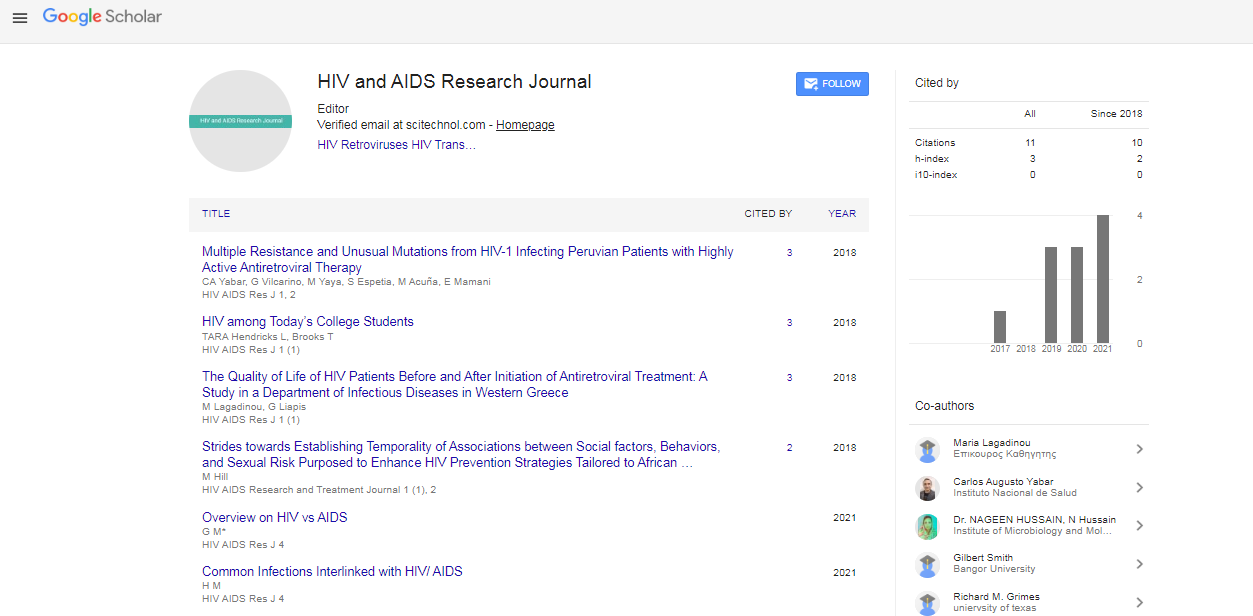Perspective, Hiv Aids Res J Vol: 6 Issue: 1
HIV Vaccines: Challenges and Opportunities for Global Health
Susan Kobie*
Department of Global Health, University of Washington, Seattle, United States of America
*Corresponding Author: Susan Kobie
Department of Global Health, University of
Washington, Seattle, United States of America
E-mail: susankobie@glh71.edu
Received date: 20 February, 2023, Manuscript No. HARJ-23-93310;
Editor assigned date: 22 February, 2023, PreQC No. HARJ-23-93310 (PQ);
Reviewed date: 09 March, 2023, QC No HARJ-23-93310;
Revised date: 16 March, 2023, Manuscript No. HARJ-23-93310(R);
Published date: 23 March, 2023, DOI: 10.4172/Harj.1000119
Citation: Kobie S (2023) HIV Vaccines: Challenges and Opportunities for Global Health. HIV AIDS Res J 6:1.
Description
HIV is a virus that attacks the immune system and leads to Acquired Immunodeficiency Syndrome (AIDS). Human Immunodeficiency Virus (HIV) is a deadly virus that weakens the immune system of the body and makes the body susceptible to various infections and diseases. HIV is primarily transmitted through the exchange of bodily fluids, such as blood, semen, vaginal secretions, and breast milk, among others. HIV attacks the CD4 cells (T cells), which play an essential role in the immune system. Without proper treatment, HIV can lead to Acquired Immunodeficiency Syndrome (AIDS), a condition that severely weakens the immune system and increases the risk of infections and certain cancers. Despite significant progress in treating HIV, the development of an effective vaccine remains the most promising way to prevent new infections.
Several clinical trials have been conducted to test the efficacy of various vaccines. However, these trials have been largely unsuccessful in producing an effective vaccine. Many of the vaccine candidates have only provided partial protection against the virus or had significant side effects. The development of an HIV vaccine is a challenging task, primarily due to the unique characteristics of the virus. HIV is a highly variable virus that mutates rapidly, making it difficult to develop a vaccine that targets all strains of the virus. Additionally, the virus has developed several mechanisms to evade the immune system, making it difficult to mount an effective immune response.
Types of HIV vaccines that have been developed and are currently being identified
Protein-based vaccines: These vaccines use HIV proteins to stimulate the immune system. The proteins can be isolated from the virus or produced synthetically. Some of the proteins used in these vaccines include the gp120 and gp41 proteins that are found on the surface of the virus.
DNA vaccines: These vaccines use a small piece of HIV DNA to stimulate an immune response. The DNA is introduced into the body through a harmless virus or directly injected into muscle tissue. The DNA contains the genetic code for the HIV protein and instructs the body to produce it, which then triggers an immune response.
Viral vaccines: These vaccines use a harmless virus to deliver HIV antigens to the immune system. The virus is genetically modified to carry the HIV antigen, which is then recognized by the immune system and triggers an immune response. Some of the viruses used as vectors include adenoviruses, poxviruses, and lentiviruses.
Whole-killed virus vaccines: These vaccines use whole, inactivated HIV viruses to stimulate an immune response. The virus is killed or inactivated to prevent it from causing an infection. However, this approach has not been successful in generating a strong immune response against HIV.
Live-attenuated virus vaccines: These vaccines use a weakened form of the HIV virus that is still able to replicate in the body. This type of vaccine has shown promise in animal studies but is not yet safe for use in humans.
Prime-boost vaccines: These vaccines use a combination of different vaccine approaches to stimulate an immune response. The first vaccine primes the immune system, while the second vaccine boosts the response. For example, a DNA vaccine may be used to prime the immune system, followed by a viral vector vaccine to boost the response.
Conclusion
The development of an effective HIV vaccine is crucial in the fight against HIV. While there are several types of HIV vaccines currently being developed, none have yet been proven to be completely effective in preventing HIV infection. However, the future of the HIV/ AIDS epidemic can be improved with ongoing innovation in vaccine development.
 Spanish
Spanish  Chinese
Chinese  Russian
Russian  German
German  French
French  Japanese
Japanese  Portuguese
Portuguese  Hindi
Hindi 